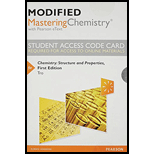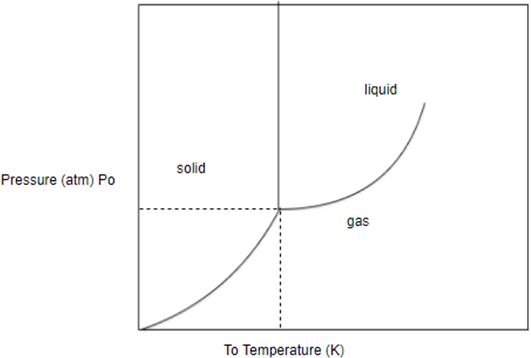
Interpretation:
Matter
(Physical substance in general which occupies space and possesses rest mass)
| Solid | Liquid | Gas |
| (1) A solid is a sample of matter that retains its shape and density when not confined. (2) Strong molecular force of attraction exist between atoms ions molecules. |
(1) A liquid is a sample of matter that conforms to shape of container in which it is held and which acquires a defined surface in the presence of gravity. (2) Weak molecular force of attraction exists between atoms/ions/molecule. |
(1) A gas is a sample of matter that conforms to the shape of container in which it is placed and acquire whole volume of container. (2) Negligible force of attraction exists between atoms/ion/molecules. |
Concept Introduction:
Physical change: physical change occurs when a substance alters its state , but does not change its chemical composition.
State of matter depends upon temperature and pressure. As temperature or pressure or both change then state of matter may also change.
Phase change: transition of a substance from one state to another state
Phase: it is defined as a homogenous portion of a system that has uniform physical and chemical characteristic.
Draw initial temperature and pressure on phase diagram identify the initial phase similarly draw final temperature and pressure on phase diagram identify the final phase. After that you can decide which phase transition occurs.
To determine:
A sample of the substance in this phase diagram is initially at and . Which phase transition occurs when the pressure is decreased to at constant temperature?

Solid to liquid.
Liquid to gas.
Solid to gas.
Liquid to solid.
Want to see the full answer?
Check out a sample textbook solution
Chapter 13 Solutions
Modified Mastering Chemistry with Pearson eText -- Standalone Access Card -- for Chemistry: Structure and Properties
- A pure substance X has the following properties: Mp=90C, increasing slightly as pressure increases; normal bp=120C; liquid vp=65mm Hg at 100C, 20 mm Hg at the triple point. (a) Draw a phase diagram for X. (b) Label solid, liquid, and vapor regions of the diagram. (c) What changes occur if, at a constant pressure of 100 mm Hg, the temperature is raised from 100C to 150C?arrow_forwardKrypton, Kr, has a triple point at 169C and 133 mmHg and a critical point at 63C and 54 atm. The density of the solid is 2.8 g/cm3, and the density of the liquid is 2.4 g/cm3. Sketch a rough phase diagram of krypton. Circle the correct word in each of the following sentences (and explain your answers). a Solid krypton at 130 mmHg (melts, sublimes without melting) when the temperature is raised. b Solid krypton at 760 mmHg (melts, sublimes without melting) when the temperature is raised.arrow_forwardWhat phase changes will take place when water is subjected to varying pressure at a constant temperature of 0.005 C? At 40 C? At 40 C?arrow_forward
 Chemistry: Principles and PracticeChemistryISBN:9780534420123Author:Daniel L. Reger, Scott R. Goode, David W. Ball, Edward MercerPublisher:Cengage Learning
Chemistry: Principles and PracticeChemistryISBN:9780534420123Author:Daniel L. Reger, Scott R. Goode, David W. Ball, Edward MercerPublisher:Cengage Learning Chemistry: The Molecular ScienceChemistryISBN:9781285199047Author:John W. Moore, Conrad L. StanitskiPublisher:Cengage Learning
Chemistry: The Molecular ScienceChemistryISBN:9781285199047Author:John W. Moore, Conrad L. StanitskiPublisher:Cengage Learning Chemistry by OpenStax (2015-05-04)ChemistryISBN:9781938168390Author:Klaus Theopold, Richard H Langley, Paul Flowers, William R. Robinson, Mark BlaserPublisher:OpenStax
Chemistry by OpenStax (2015-05-04)ChemistryISBN:9781938168390Author:Klaus Theopold, Richard H Langley, Paul Flowers, William R. Robinson, Mark BlaserPublisher:OpenStax Chemistry & Chemical ReactivityChemistryISBN:9781133949640Author:John C. Kotz, Paul M. Treichel, John Townsend, David TreichelPublisher:Cengage Learning
Chemistry & Chemical ReactivityChemistryISBN:9781133949640Author:John C. Kotz, Paul M. Treichel, John Townsend, David TreichelPublisher:Cengage Learning Chemistry & Chemical ReactivityChemistryISBN:9781337399074Author:John C. Kotz, Paul M. Treichel, John Townsend, David TreichelPublisher:Cengage Learning
Chemistry & Chemical ReactivityChemistryISBN:9781337399074Author:John C. Kotz, Paul M. Treichel, John Townsend, David TreichelPublisher:Cengage Learning Chemistry: Principles and ReactionsChemistryISBN:9781305079373Author:William L. Masterton, Cecile N. HurleyPublisher:Cengage Learning
Chemistry: Principles and ReactionsChemistryISBN:9781305079373Author:William L. Masterton, Cecile N. HurleyPublisher:Cengage Learning





